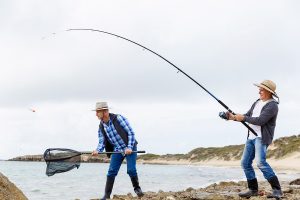Choosing your Rod
 Choosing the correct salmon fishing rods from the walls upon walls of different types displayed can be a bit of a difficult task, simply because of the huge selection involved.
Choosing the correct salmon fishing rods from the walls upon walls of different types displayed can be a bit of a difficult task, simply because of the huge selection involved.
There are many different compositions, lengths, weights, and set ups on rods used for salmon fishing.
The type of rod you choose will often be dictated according to the salmon fishing that you do, but there are some basic rules to keep in mind when choosing any rod whether you are looking for a salmon casting rod, saltwater spinning rod, or trolling rod.
Length of the rod butt
This is the amount of rod behind the reel, and a good rule of thumb is to have six to twelve inches available. This length is needed to give you some extra support when you are playing or landing a fish; you will be able to use your stomach for some added leverage. Without the rod supported on your stomach, you would have to do all the work with your arms, and that will tire you out quickly.
On the other hand, a butt that is too long will mean you have to stretch your arms out to an uncomfortable level, not to mention that if it’s a salmon spinning rod you’ll need more room for your cast. Finally, consider the specific needs for trolling; saltwater boat rods with butts that are too short will not sit in the holder, slipping out and overboard with the first big Chinook strike or wave they catch, so make sure your salmon trolling rod (commonly called “mooching” rods) has the proper butt length to allow for that sturdy seat in the boat while you’re trolling around the water.
Weight
Light is the key word here; purchase the lightest rod that you can find. Travelling down a river bank in the brush with heavy equipment can cause fatigue over time and is very cumbersome. You should also take a look at the weight balance of the rod you are looking at; find where the rod balances by placing it on your forefinger. The balance point should be where you would naturally put your hand while you fish; if not, then look for a different rod.
Specific fishing
Shorter six foot, to nine foot salmon fly fishing rods can provide you with a lot of excitement when you are out casting for salmon such as coho or steelhead, as they make even smaller fish feel huge on the landing. If you are out for the big guys like chinook, then you don’t need the extra excitement and anywhere from size 8 (8 foot) to size 10 rod will be your most common size for big salmon.
When you are looking for saltwater boat rods, get mooching rods that are ten feet long or so; they will put the lines out far enough that they don’t get tangled., and also gets the bait out far enough from your boat. Mooching rods typically also have soft tips, which will rise on a bite by a fish at the other end.
If you tend to go fishing for salmon by yourself, you are going to want to remember that landing them can be really difficult if your rod is too long. You need to be able to net the fish as well as keep your line tight; the longer your rod, the higher you are going to have to lift it to get that fish within netting distance of the boat. If you are bar fishing and you are on shore, it’s easy enough to drag the fish up onto the bar by backing up, but if you’re in a tight spot then you really have to be careful and watch you don’t loose the fish.
Go Salmon Fishing Tip:
Horsing and overplaying – two things that can really ruin your catch are “horsing” and “overplaying.” Horsing is a term used when an angler is using excessive force and pulling back on their salmon fishing rod, which causes your line to snap, rod to break or worse the fish to have damage that could lead to waste or death. Overplay is a term used when an angler is playing the fish too long.
This can potentially cause the same things as horsing such as damage to your salmon fishing rod, gear, or loss of a fish by exhaustion, or breaking off. This practice can also get a lot of people fishing around you frustrated if they are waiting until you finish playing the fish so they can begin casting again. It’s proper etiquette to find the medium between horsing and overplay so everyone is happy including the fish and your rod.

